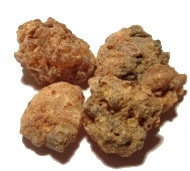Myrrh, An Herbal Medicine Once Worth More Than Gold
https://southernappalachianherbs.blogspot.com/2021/01/myrrh-herbal-medicine-once-worth-more.html

It is strange to think that Myrrh, and its close relative Frankincense, were herbs once more valuable than gold. When the Magi brought those gifts to the Christ child, they were presenting the most precious commodities in the ancient world. Myrrh was both a suitable offering, rich in religious and cultural tradition, but it was also the same powerful medicinal herb that we can purchase relatively inexpensively today. By Pliny the Elder’s time, it was the trade of Myrrh that had made the Arab spice trade the source of tremendous wealth. Long before that, however, Myrrh was used in everything from Egyptian perfumes and fumigants, to the Hebrew anointing of Levitical priests. Now, it is most often used in the incense burned in many Catholic Churches at Mass. However, Myrrh is still a potent and important medicine in the modern herbal apothecary.
Why would this incense be so esteemed in the ancient Middle East? Well, the first answer is obvious - it was a hot place to live, with scarce water, poor hygiene and sanitation. People and their surroundings often smelled very foul. The heavy scent of Myrrh was surely a relief to anyone who could afford it. Beyond that though, consider the common maladies of the day. Lips cracked form sun and wind, cuts and scratches that could easily become infected, boils, tooth aches and infections of the gums, mouth and throat, various digestive complaints and issues caused by insect bites. Myrrh was a veritable panacea for the maladies of the time.
According to the Physicians’ Desk Reference for Herbal Medicines:
Myrrh is stated to possess antimicrobial, astringent, carminative, expectorant, anticatarral, antiseptic and vulnerary properties. Traditionally, it has been used for aphthous ulcers, pharyngitis, respiratory catarrh, common cold furunculosis, wounds and abrasions, and specifically for mouth ulcers, gingivitis and pharyngitis. Myrrh’s local astringent, disinfectant and granulation-promoting effects are as a result of its essential oil (consisting mainly of sesquiterpenes) and amaroids.
Unproven uses: In folk medicine, Myrrh is occasionally used internally as a carminative for nonspecific intestinal infections and also as an expectorant for coughs. Folk medicine uses have also included stimulating the appetite and the flow of digestive juices.
Chinese Medicine: Uses include carbuncles, furuncles, wounds (as a styptic), amenorrhea and abdominal tumors.
Indian Medicine: Among uses in Indian medicines are menstrual disorders, stomach complaints, wounds, ulcers, and inflammations of the skin and mouth.
Contraindications: Not to be used during pregnancy. Not to be used while breastfeeding…..
No health hazards or side effects are known in conjunction with the proper administration of designated therapeutic doses
So, what is Myrrh? “Myrrh, (from Arabic murr, “bitter”), bitter-tasting, agreeably aromatic, yellow to reddish brown oleoresinous gum obtained from various small, thorny, flowering trees of the genus Commiphora, of the incense-tree family (Burseraceae). The two main varieties of myrrh are herabol and bisabol. Herabol myrrh is obtained from C. myrrha, which grows in Ethiopia, Arabia, and Somalia, while bisabol myrrh is obtained from C. erythraea, which is an Arabian species of similar appearance. Myrrh trees are found on parched rocky hills and grow up to 3 m (9 feet) tall” - Encyclopedia Britannica
Mrs. Grieves states of Myrrh in A Modern Herbal,
Astringent, healing. Tonic and stimulant. A direct emmenagogue, a tonic in dyspepsia, an expectorant in the absence of feverish symptoms, a stimulant to the mucous tissues, a stomachic carminative, exciting appetite and the flow of gastric juice, and an astringent wash.
It is used in chronic catarrh, phthisis pulmonalis, chlorosis, and in amenorrhoea is often combined with aloes and iron. As a wash it is good for spongy gums, ulcerated throat and aphthous stomatitis, and the tincture is also applied to foul and indolent ulcers. It has been found helpful in bronchorrhoea and leucorrhoea. It has also been used as a vermifuge….
Myrrh is a common ingredient of toothpowders, and is used with borax in tincture, with other ingredients, as a mouth-wash.The Compound Tincture, or Horse Tincture, is used in veterinary practice for healing wounds.
The late herbalist, Michael Moore indicates Myrrh as useful in:
Follicular conjunctivitis; as an eyewash at the onset of styes. Acute periodontitis, topically. Acute aphthous stomatitis with painful inflammation. Acute early stages of herpes, topically. Acute sinusitis with ulcerations (as a nasal spray). Intrinsic humid asthma with moist cough. Acute hot dry bronchitis in aged with secretions. Chronic bronchitis with profuse secretions and debility. Bronchorrhea. Chronic cough with debility. Chronic cystorrhea w/out active inflammation, in exhausted, feeble states. Chronic cystitis/urethritis without active inflammation. Chronic nephritis without active inflammation. Gastroenteritis with mucus hypersecretions. Ulcers, subacute or chronic, not inflamed but congested. Decubitus, recuperative (externally). Herpes simplex, to speed regeneration (externally). Skin ulcers on oily, moist surfaces (externally). Endometritis/metritis, with fever and with senescent neutrophils or immuno suppression (with Baptisia and Echinacea). Acute vaginitis (internally). Blood serum levels: white blood cell depression, any cause (w/Echinacea). Endogenous infections, with depressed WBC. Cancer, immunosuppression from therapy; or immunosuppression with marked WBC depression( with Echinacea). To stimulate innate immunity. Immunosuppression, recent, from stress (with Echinacea). Leukopenia (with Echinacea)
I take Myrrh daily, as part of the Great Swedish Bitters to which I attribute great improvements in my health. Most often, I use Myrrh as an ingredient in a Comfrey salve to heal wounds - Comfrey is so effective in proliferating cells that it can close a wound so quickly that it may seal germs inside and cause an infection. The addition of Myrrh, as a disinfectant, makes such risks less likely. Mountain Rose Herbs sells Myrrh for $12.75, for 4 oz.. No longer is Myrrh more valuable than gold, but it is still a precious herb.
Photo credit: By derivative work: Photohound (talk)IncenseWikiVers.jpg: Transferred from en.wikipedia to Commons by Trengarasu using CommonsHelper.The original uploader was Sjschen at English Wikipedia. - IncenseWikiVers.jpg, CC BY-SA 3.0,
https://commons.wikimedia.org/w/index.php?curid=5723891







